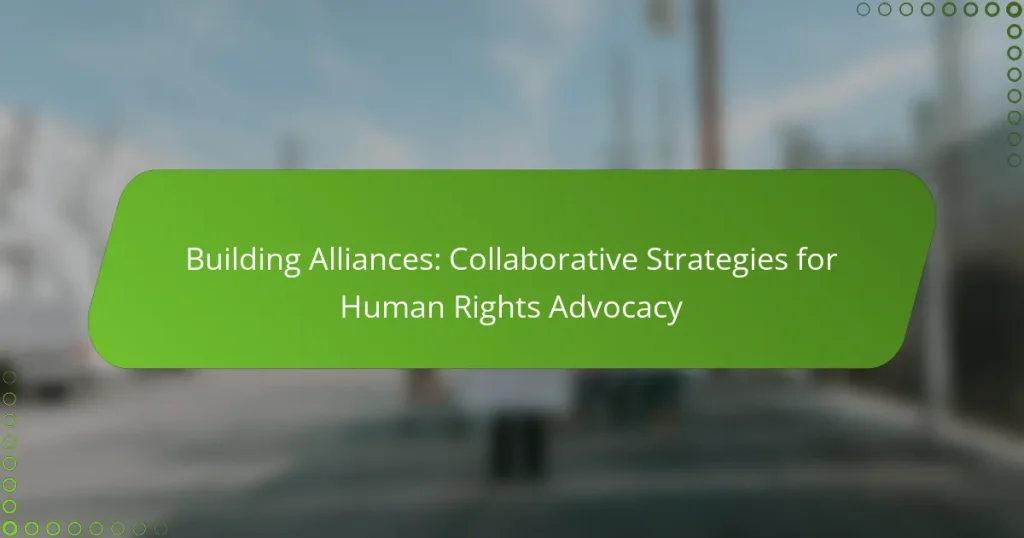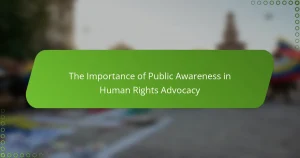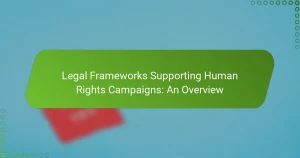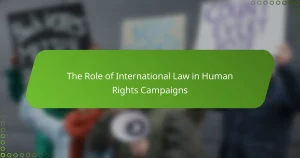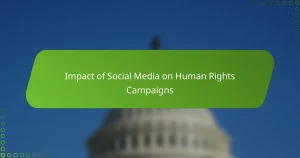Building alliances in human rights advocacy is essential for fostering effective collaboration among diverse stakeholders. Key principles include mutual respect, shared goals, effective communication, and inclusivity, which enhance trust and understanding while addressing conflicts. Successful strategies for collaboration involve establishing trust, aligning goals, and maintaining clear communication, along with regular assessments of partnership progress. However, challenges such as differing organizational priorities, resource limitations, communication barriers, and political pressures can complicate these alliances. This article explores these foundational elements and strategies, offering insights into the complexities of building impactful partnerships in human rights advocacy.
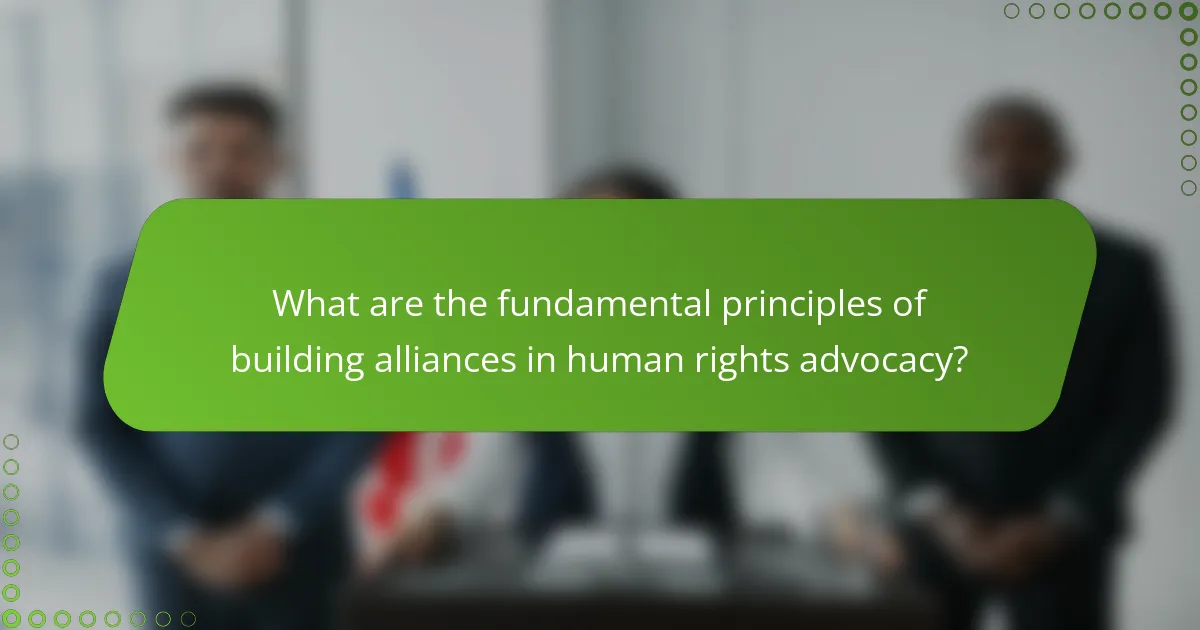
What are the fundamental principles of building alliances in human rights advocacy?
The fundamental principles of building alliances in human rights advocacy include mutual respect, shared goals, and effective communication. Mutual respect fosters trust among diverse stakeholders. Shared goals ensure that all parties work towards a common purpose, enhancing collaboration. Effective communication promotes transparency and understanding, crucial for resolving conflicts. Additionally, inclusivity allows for diverse perspectives, enriching the advocacy efforts. These principles have been validated by successful case studies in human rights movements, demonstrating their effectiveness in creating impactful alliances.
How do collaborative strategies enhance human rights advocacy?
Collaborative strategies enhance human rights advocacy by pooling resources and expertise from diverse organizations. This collaboration leads to a stronger, unified voice that can effectively challenge injustices. For instance, partnerships between local NGOs and international bodies can amplify advocacy efforts. Joint campaigns can reach wider audiences, increasing awareness and support for human rights issues. Research shows that coalitions can lead to successful policy changes, as seen in the 2018 Global Compact for Migration. Collaborative strategies also foster knowledge sharing, improving the effectiveness of advocacy tactics. By working together, organizations can leverage each other’s strengths, creating a more impactful movement for human rights.
What role do partnerships play in amplifying advocacy efforts?
Partnerships significantly enhance advocacy efforts by pooling resources and expertise. Collaborative initiatives expand reach and influence. They enable organizations to share knowledge and strategies. Partnerships can also mobilize broader community support. For instance, joint campaigns often attract more attention and media coverage. Research shows that coalitions can increase the effectiveness of advocacy by up to 50%. This data highlights the power of collaboration in achieving common goals.
How can shared goals strengthen alliances among organizations?
Shared goals can strengthen alliances among organizations by fostering a unified vision and direction. When organizations align their objectives, they create a sense of purpose. This alignment enhances collaboration and resource sharing. Organizations are more likely to work together effectively when they have common targets. Research indicates that shared goals lead to increased trust and commitment among partners. Trust is essential for maintaining long-term alliances. Furthermore, organizations can leverage each other’s strengths to achieve these shared goals. This collaborative effort can amplify their impact in human rights advocacy.
Why is diversity important in building effective alliances?
Diversity is important in building effective alliances because it fosters a range of perspectives and ideas. This variety enhances problem-solving capabilities and innovation. Organizations with diverse members can better understand and address the needs of different communities. Research shows that diverse teams are 35% more likely to outperform their homogeneous counterparts. Additionally, diverse alliances can strengthen credibility and trust among stakeholders. This is particularly crucial in human rights advocacy, where representation matters. Ultimately, diversity leads to more comprehensive and effective strategies for achieving common goals.
What unique perspectives do different organizations bring to human rights advocacy?
Different organizations bring diverse perspectives to human rights advocacy based on their missions and experiences. For instance, grassroots organizations often focus on local issues and community engagement. They understand the specific needs and challenges faced by marginalized populations. International organizations typically address broader systemic issues and work on policy-level changes. They leverage global networks to influence governments and institutions. Academic institutions contribute research and data analysis to inform advocacy strategies. Their findings can highlight trends and provide evidence for human rights violations. Additionally, advocacy groups centered on specific issues, such as women’s rights or environmental justice, bring specialized knowledge. This diversity enriches the human rights discourse and enhances collaboration among organizations.
How can inclusive approaches improve advocacy outcomes?
Inclusive approaches can improve advocacy outcomes by ensuring diverse perspectives are represented. This representation fosters a deeper understanding of the issues at hand. It leads to more comprehensive solutions that address the needs of all stakeholders. Research shows that inclusive advocacy efforts result in greater community engagement. For instance, a study by the World Bank found that inclusive policies can increase project success rates by up to 30%. This engagement builds trust and strengthens alliances. Stronger alliances enhance the effectiveness of advocacy campaigns. Ultimately, inclusive approaches lead to more sustainable and impactful advocacy outcomes.
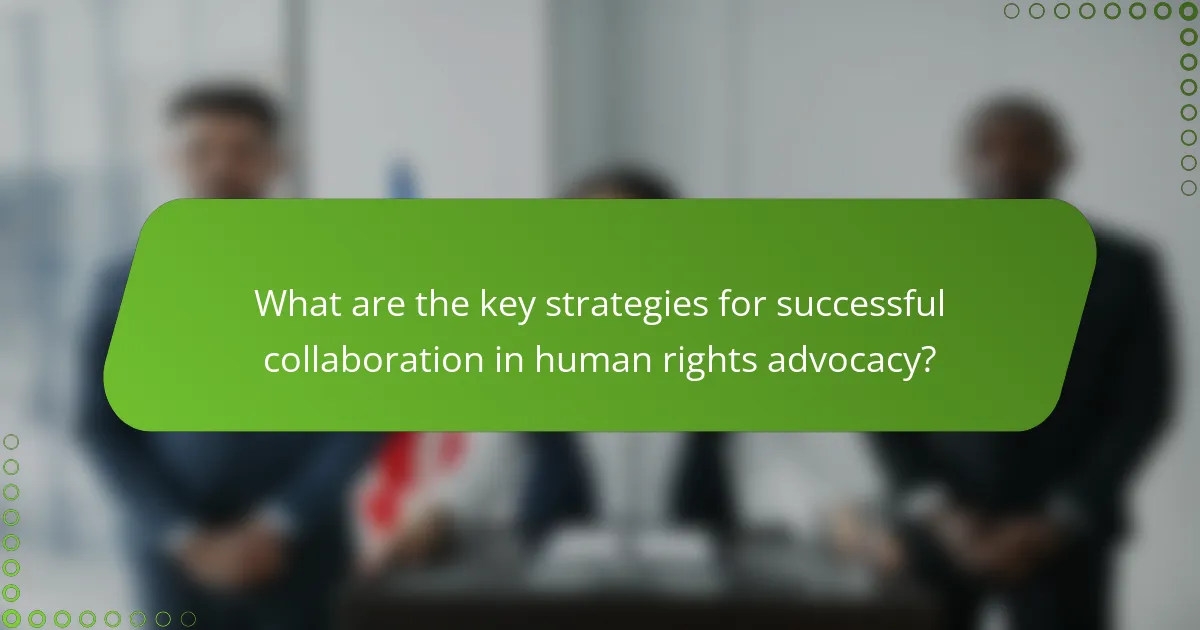
What are the key strategies for successful collaboration in human rights advocacy?
Key strategies for successful collaboration in human rights advocacy include building trust, establishing clear communication, and aligning goals. Trust fosters open dialogue and cooperation among partners. Clear communication ensures that all stakeholders understand their roles and responsibilities. Aligning goals helps to create a unified vision for advocacy efforts.
Regularly assessing the partnership’s progress is essential for maintaining effectiveness. Engaging diverse stakeholders broadens perspectives and resources. Utilizing technology can enhance coordination and outreach efforts. Finally, sharing successes and challenges openly strengthens relationships and encourages ongoing collaboration.
How can organizations identify potential allies?
Organizations can identify potential allies by assessing shared goals and values. They should analyze their mission statements and objectives for alignment. Networking at events relevant to their cause is crucial. Engaging in discussions with other organizations can reveal common interests. Utilizing social media for outreach helps identify like-minded entities. Researching existing partnerships within their network can uncover potential allies. Evaluating past collaborations provides insight into effective alliances. These strategies enhance the likelihood of successful partnerships in advocacy efforts.
What criteria should be used to assess compatibility with potential partners?
Criteria to assess compatibility with potential partners include shared values, goals, and interests. Shared values create a foundation for mutual understanding. Common goals ensure both parties work towards the same outcomes. Aligning interests fosters collaboration and reduces conflict. Communication styles must also be compatible for effective dialogue. Trustworthiness is essential for building strong partnerships. Previous experiences in advocacy can indicate reliability. Finally, cultural awareness enhances sensitivity to diverse perspectives. These criteria promote successful alliances in human rights advocacy.
How can organizations leverage existing networks to build alliances?
Organizations can leverage existing networks to build alliances by identifying shared goals and values. They should engage in open communication with network members. This can foster trust and collaboration. Organizations can also share resources and expertise within the network. This approach strengthens partnerships and enhances collective impact. According to a study by the Stanford Social Innovation Review, collaboration can lead to more effective advocacy outcomes. By tapping into existing relationships, organizations can amplify their reach and influence.
What communication strategies are vital for effective collaboration?
Effective collaboration requires clear and open communication strategies. These strategies include active listening, which ensures all voices are heard. Regular updates maintain transparency among team members. Utilizing collaborative tools enhances information sharing and coordination. Setting clear goals aligns team efforts towards a common objective. Establishing feedback loops allows for continuous improvement in communication. These strategies have been shown to increase team productivity and engagement in collaborative environments.
How can transparency and trust be established among partners?
Transparency and trust among partners can be established through open communication and shared goals. Regular meetings facilitate information exchange and clarify expectations. Documenting agreements creates accountability and reduces misunderstandings. Encouraging feedback promotes a culture of honesty and responsiveness. Sharing resources and successes fosters a sense of partnership. Studies show that organizations with transparent practices report higher levels of trust. For instance, a 2020 report by the Transparency International revealed that transparency improves collaboration effectiveness by 30%.
What tools can facilitate ongoing communication between allied organizations?
Digital communication platforms can facilitate ongoing communication between allied organizations. Tools such as Slack, Microsoft Teams, and Zoom enable real-time messaging and video conferencing. These platforms allow for instant sharing of updates and documents. Project management tools like Asana and Trello help organize tasks and timelines collaboratively. Email services remain essential for formal communication and information sharing. Social media platforms can be used for broader outreach and engagement. Surveys and feedback tools like SurveyMonkey can gather input from stakeholders. Overall, these tools enhance collaboration and streamline communication efforts among allied organizations.
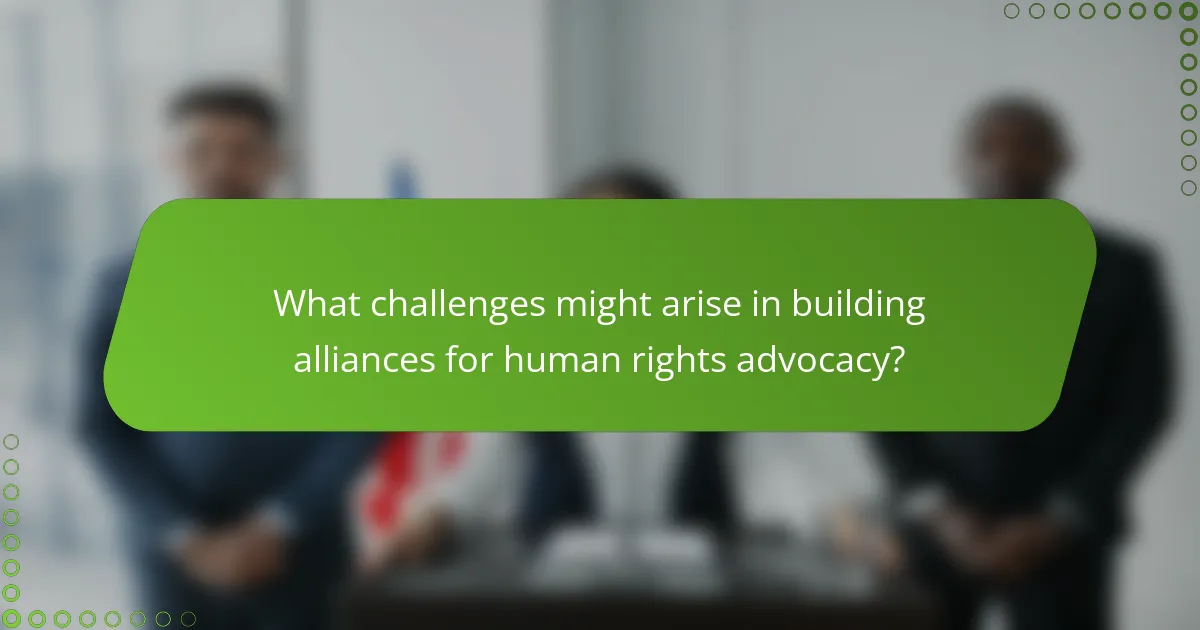
What challenges might arise in building alliances for human rights advocacy?
Challenges in building alliances for human rights advocacy include differing priorities among organizations. Diverse agendas can lead to conflicts in focus and strategy. Resource limitations also pose a significant challenge. Many organizations struggle with funding, which affects their ability to collaborate effectively. Additionally, communication barriers can hinder collaboration. Misunderstandings may arise from different terminologies or cultural contexts. Trust issues may also emerge, particularly if past collaborations were unsuccessful. Finally, political pressures can complicate alliances. Organizations may face external threats that impact their willingness to collaborate. These factors collectively create a complex environment for building effective alliances in human rights advocacy.
How can conflicting priorities impact collaboration?
Conflicting priorities can significantly hinder collaboration. When team members have differing goals, it creates misalignment. This misalignment can lead to misunderstandings and decreased motivation. According to a study by the Project Management Institute, 37% of projects fail due to a lack of alignment on priorities. Additionally, conflicting priorities can result in resource allocation issues. Teams may struggle to agree on how to distribute time and funding effectively. This can lead to frustration and a lack of trust among collaborators. Ultimately, unresolved conflicting priorities can derail collaborative efforts and impede progress toward shared objectives.
What strategies can help resolve disputes between partner organizations?
Effective strategies for resolving disputes between partner organizations include open communication, mediation, and establishing clear agreements. Open communication fosters transparency and understanding. It allows both parties to express their concerns and expectations. Mediation involves a neutral third party to facilitate discussions. This can help both sides reach a mutually agreeable solution. Establishing clear agreements outlines roles, responsibilities, and conflict resolution processes. This minimizes misunderstandings and sets a framework for addressing issues. Research shows that organizations with defined conflict resolution strategies experience fewer disputes and improved collaboration.
How can organizations navigate power dynamics within alliances?
Organizations can navigate power dynamics within alliances by establishing clear communication and shared goals. Open dialogue fosters trust and ensures all parties feel valued. Regular meetings help address concerns and adjust strategies collaboratively. Additionally, organizations should recognize and respect each member’s strengths and contributions. This approach promotes equity and minimizes power imbalances. Research indicates that inclusive decision-making enhances the effectiveness of alliances. A study by the Stanford Social Innovation Review highlights that diverse perspectives lead to better problem-solving outcomes. By prioritizing inclusivity and transparency, organizations can effectively manage power dynamics in alliances.
What are the potential risks of forming alliances?
Potential risks of forming alliances include loss of autonomy and conflicting interests. When organizations ally, they may need to compromise on their values. This can dilute their mission and objectives. Additionally, differing priorities can lead to tension. Misalignment can cause inefficiencies and hinder progress. Trust issues may arise, impacting collaboration. If one party fails to meet commitments, it can damage relationships. Lastly, public perception may shift negatively if alliances are viewed as opportunistic.
How can organizations mitigate the risks associated with collaborative efforts?
Organizations can mitigate the risks associated with collaborative efforts by establishing clear communication channels. This ensures that all parties understand their roles and responsibilities. Regular meetings can help address concerns promptly. Creating formal agreements can outline expectations and reduce misunderstandings. Training sessions can enhance collaboration skills among team members. Implementing a risk assessment framework allows organizations to identify potential issues early. Monitoring progress through evaluations can help in making necessary adjustments. These strategies collectively foster a more secure collaborative environment.
What are the ethical considerations in alliance-building?
Ethical considerations in alliance-building include transparency, mutual respect, and accountability. Transparency ensures that all parties understand the goals and processes involved. Mutual respect fosters trust and collaboration among diverse stakeholders. Accountability involves holding each other responsible for actions and commitments. These principles help prevent exploitation and promote equitable partnerships. Research indicates that ethical alliances can enhance collective impact in human rights advocacy. A study by the International Human Rights Clinic emphasizes the importance of these ethical frameworks in successful collaborations.
What best practices can enhance the effectiveness of alliances in human rights advocacy?
Effective alliances in human rights advocacy can be enhanced through clear communication and shared goals. Establishing transparency fosters trust among partners. Regular meetings help maintain alignment on objectives and strategies. Diverse representation strengthens advocacy efforts by incorporating various perspectives. Building capacity through training ensures all members are equipped with necessary skills. Engaging in joint campaigns amplifies impact and visibility. Utilizing data-driven approaches supports evidence-based advocacy. Finally, evaluating and adapting strategies based on feedback enhances long-term effectiveness.
How can organizations measure the success of their collaborative strategies?
Organizations can measure the success of their collaborative strategies through specific metrics. Key performance indicators (KPIs) such as joint project outcomes, stakeholder engagement levels, and resource sharing effectiveness are essential. Surveys can assess participant satisfaction and perceived value of collaboration. Tracking the achievement of shared goals also provides insight into success. Data analysis from collaborative projects can reveal efficiency and impact. For instance, a study by the Stanford Social Innovation Review found that 70% of successful collaborations reported improved outcomes through shared metrics. This demonstrates the importance of measurable results in evaluating collaborative efforts.
What role does continuous evaluation play in sustaining effective alliances?
Continuous evaluation is essential for sustaining effective alliances. It allows partners to assess progress and identify areas for improvement. Regular feedback helps in adapting strategies to changing circumstances. This process fosters transparency and trust among alliance members. It also ensures that goals remain aligned with the mission of human rights advocacy. Research indicates that organizations that engage in continuous evaluation have higher success rates in collaborative efforts. For instance, a study by the Stanford Social Innovation Review highlights that ongoing assessments lead to more resilient partnerships. Overall, continuous evaluation is a critical mechanism for maintaining effective and adaptive alliances.
Building Alliances is a critical entity in the realm of human rights advocacy, focusing on collaborative strategies that enhance effectiveness. The article outlines fundamental principles such as mutual respect, shared goals, and effective communication, which are essential for fostering successful partnerships. It emphasizes the importance of diversity, inclusivity, and clear communication in strengthening alliances and achieving common objectives. Furthermore, the article discusses the challenges organizations face in collaboration, the ethical considerations involved, and best practices for measuring success and sustaining effective alliances in the pursuit of human rights.
